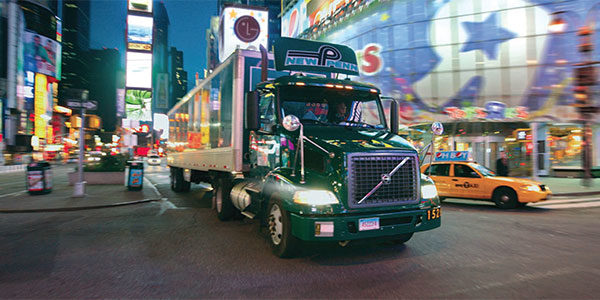Space invaders

Transportation intermediaries have gained more clout in the less-than-truckload (LTL) industry than ever before, a movement that is changing the landscape for all concerned.
Freight brokers and third-party logistics service providers (3PLs) that also offer brokerage services have long been involved in the LTL segment. However, their presence has been small compared with the truckload category, where there is far more freight to be booked.
In recent years, brokers have penetrated the LTL business at a faster clip than they have the truckload market. According to estimates from Milwaukee-based investment firm Robert W. Baird & Co., LTL volume handled by brokers roughly doubled between 2007 and 2011. Growth in broker-handled truckload volumes rose at a more modest clip during that period, the firm said.
In 2007, LTL represented less than 10 percent of a publicly traded broker's traffic mix, according to Baird estimates. In 2011, LTL accounted for about 15 percent of total broker-handled volume, the firm said. Baird based its estimates on company data.
C.H. Robinson Worldwide Inc., the nation's largest broker and also a major 3PL, said its fourth-quarter and full-year 2012 volumes tendered to LTL carriers rose 16 percent from the year-earlier periods. By contrast, its fourth-quarter and full-year truckload volumes rose 12 percent and 10 percent, respectively, over year-ago levels, Eden Prairie, Minn.-based Robinson said.
The recent push by brokers into the LTL arena began in the 2006-2007 period, when a nasty freight recession spawned truck overcapacity. As demand waned and LTL carriers were stuck with too much supply, they became increasingly receptive to the services of brokers to help procure freight. The attraction intensified as the broader economic recession caused shipper demand to plummet further. The adoption of sophisticated and functional information technology made it easier and more efficient for brokers to match loads with capacity, but to do so on the shipper's terms rather than the carrier's.
However, that economic environment is history. In the past four years, LTL carriers have rationalized capacity, repeatedly raised their rates, and have become more selective in the companies from whom they'll accept freight. As the pendulum has swung, so has carrier executives' antipathy toward third parties who they feel do little more than scour load boards looking for the lowest price.
Jeffrey A. Rogers, president of YRC Freight, the long-haul unit of LTL carrier YRC Worldwide Inc., acknowledged that brokers and 3PLs have become increasingly embedded in YRC Freight's traffic mix. That doesn't mean he likes it, though. Rogers warned he will use the hammer of capacity allocation, if necessary, to thwart the efforts of those intermediaries he calls "rate trolls."
"The big [intermediaries] are figuring it out," Rogers said. "They'd better bring value to the relationship or they will be out of capacity."
Several 3PL and broker executives are keenly aware of the shift. The days of brokers' being welcomed to the table by carriers only to work some type of capacity arbitrage are over, they say.
"If a broker already has a lot of LTL freight, he will be OK. But if you don't, you may find yourself struggling" to get adequate capacity at reasonable prices, said John E. Wagner Jr., president of Wagner Logistics, a Kansas City-based 3PL.
Wagner said 3PLs often underestimate the unique and challenging characteristics of LTL transport, notably the complex pricing scenarios and carrier rules, and the multiple stops and cross-docking events that can result in longer transit times, delivery variability, and additional handling, which ups the chances of freight damage. For these reasons, along with the carriers' newfound pricing and capacity leverage, Wagner is leery about making a big push into LTL; his company solicits LTL freight only for customers that have an existing warehousing relationship with his firm.
CHANGE IN STRATEGY
In contrast to four or five years ago, when a broker courting LTL users would often lead its pitch with projected price savings, today's savvy intermediaries emphasize the mutual benefits for shippers and carriers, and are honest with shippers about what they should expect to pay. "I can guarantee to a shipper that an LTL carrier will be asking for more money," said Ben Cubitt, senior vice president, engineering and consulting for Transplace, a Dallas-based 3PL. "I will tell them that six months out, they will be looking at a 3- to 6-percent rate increase."
Cubitt said Transplace is very active in the LTL space, mostly with larger customers that mainly ship truckload and have a peripheral amount of LTL business, and for smaller, less shipping-savvy customers who tender a relatively small amount of LTL and often get taken to the cleaners due to their lack of leverage and their ignorance of the pricing landscape. Cubitt said Transplace works hard at maintaining strong carrier relations, something many third parties ignore or neglect in their search for spot market freight they can mark up.
Evan Armstrong, president of Armstrong & Associates, a West Allis, Wis.-based consultancy that follows the 3PL and brokerage businesses, said the nature of an intermediary's involvement depends both on its level of sophistication, and the size and complexity of the relationship with the shipper.
If the intermediary manages a large-scale transportation network, it will focus on optimizing the shipper's investment by selecting carriers and modes tailored to the customer's needs, Armstrong said. Larger 3PLs have invested heavily in transportation management systems to maximize customers' transportation spend. Many 3PLs run network optimization programs that consolidate LTL shipments into multistop truckloads, an approach that, if used correctly, can save a shipper as much as 15 percent a year in freight costs, according to Armstrong. This type of relationship generates "a lot of value" for the customer, he said.
By contrast, in a transaction-based relationship, the broker or 3PL tries to maximize its gross margin by buying freight wholesale and then charging retail, according to Armstrong. "The focus is tactical and the planning horizon is short," he said. "Outside of finding its customer [the] carrier capacity and resolving any service problems, the broker is generating little value."
For a broker or 3PL, having the density is more than half the battle. Kane Is Able, a Scranton, Pa.-based 3PL, will arrange for truckload freight for a large customer to move with multiple LTL consignments in one trailer. For example, Kane will manage the haulage of LTL shipments commingled with truckload freight for a big-box retailer from Los Angeles to Chicago. Once the truckload freight is offloaded, the rig continues on with the LTL shipments.
This "zone-skipping" approach results in lower costs and better service for LTL shippers because they piggyback on the big retailer's density and encounter fewer cross-docking scenarios, said Mike Albert, Kane's senior vice president of transportation and quality. Meanwhile, the carrier benefits by filling up half its trailer with truckload shipments, Albert added.
"We create value for everyone," he said. Kane estimated that one-stop truckload service accounts for about 20 percent of its volume.
Albert said an intermediary's success in the LTL market requires having a robust physical network and a deep knowledge of its cost structure so it doesn't fall victim to the vagaries of the LTL game and underprice or overprice its services.
As he puts it, "You need to price it with an LTL feel."
Related Articles

Copyright ©2024. All Rights ReservedDesign, CMS, Hosting & Web Development :: ePublishing